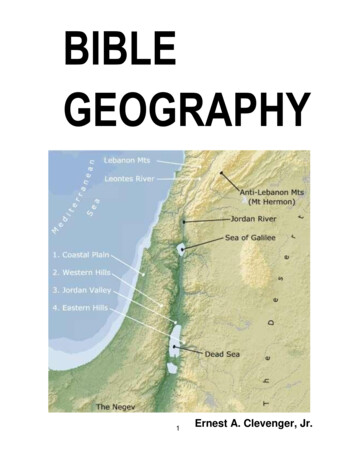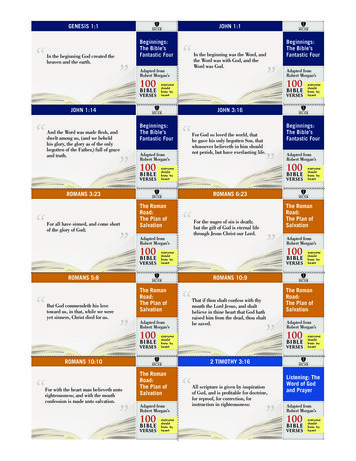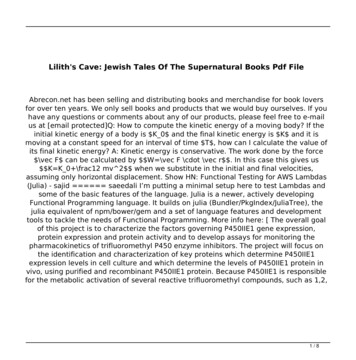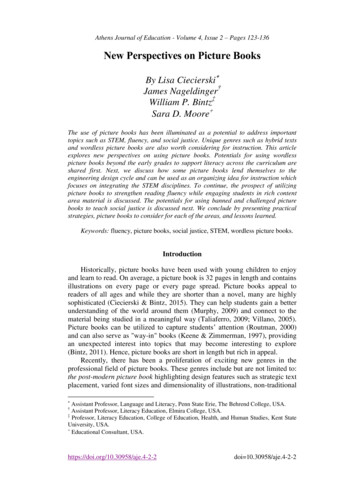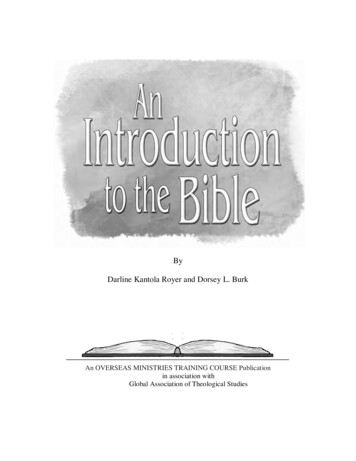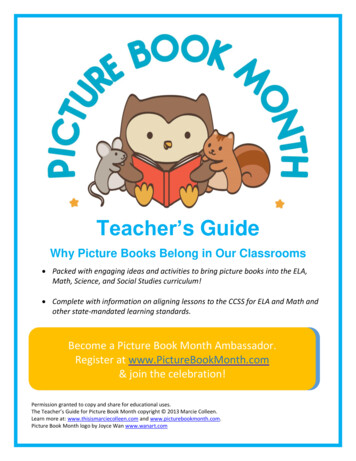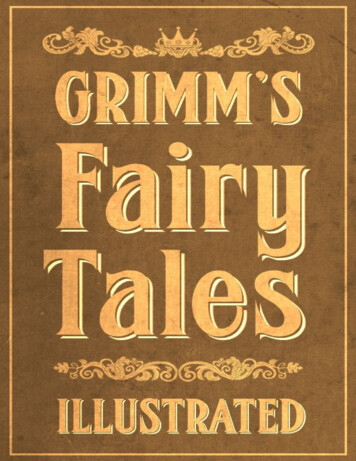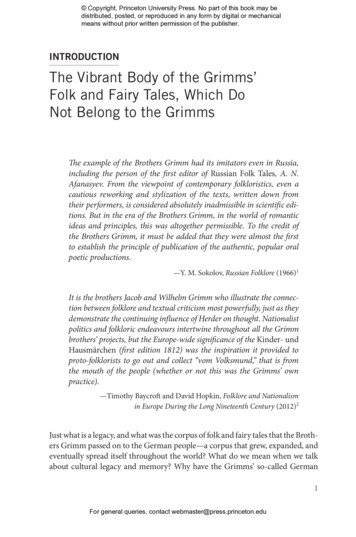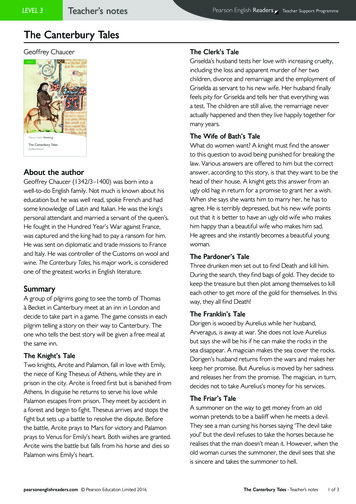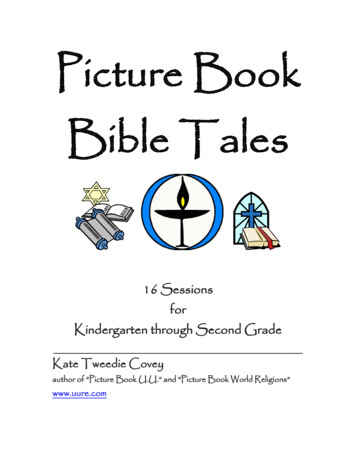
Transcription
Picture BookBible Tales16 SessionsforKindergarten through Second GradeKate Tweedie Coveyauthor of “Picture Book U.U.” and “Picture Book World Religions”www.uure.com
Copyright 2010 Kate Tweedie CoveyCopyright v2 2012 Kate Tweedie CoveyContact information: Kate Tweedie Covey2307 Calais Dr. #CLongmont, CO 80504katiecovey@gmail.comwww.uure.comMany thanks to the teachers for Fall, 2009 at Boulder Valley U.U. Fellowship who fieldtested this curriculum: Evan Kneale, Hope Collins, Laura McCollom, Lu Wright andJohn Hoebel, Jenn Weyermann, Angie Judd, and Elena Jones2
Introduction to Picture Book Bible Tales . 4Ordering The Picture Books . 6Book List . 7About Teaching Bible Tales in a U.U. Congregation . 9Parent or Teacher Orientation Workshop . 11Principles and Sources in Children’s Language . 12Do-Re-Mi UU Principles and Sources (sung to the tune of Do-Re-Mi). 14How to Read a Picture Book . 15Things to Do in Advance . 16Adapting for more/fewer sessions . 18Session # 1 About the Bible . 20Session # 2 Adam and Eve. 38Session # 3 Cain and Abel . 44Session # 4 Noah . 52Session # 5 Joseph . 61Session # 6 The Moses Basket . 70Session # 7 Exodus . 76Session # 8 The Story of Queen Esther . 84Session # 9 Daniel in the Lions’ Den. 92Session #10 Jonah and the Great Fish. 99Session #11 David and Goliath . 105Session #12 The Wisdom Bird: A Tale of Solomon and Sheba . 109Session #13 Jesus . 116Session #14 Mary, Mother of Jesus . 121Session #15 The Easter Story . 133Session #16 Your Own Picture Book . 1393
Introduction to Picture Book Bible TalesWelcome to Picture Book Bible Tales! This curriculum is fun, friendly and concise withteachable moments that introduce classic Bible Tales to young elementary children.It’s easy for Teachers to use with:Heart melting picture books as the focus of the session.A clear and simple session plan.Ready to copy parent take home sheets/ classroom door page.Multiple options for activities for advance planners and Saturday night planners.It’s easy for Directors and Coordinators to use with:An Amazon Listmania List of all the Picture Books so you can order them usedor new, whichever ones you need.A complete booklist so you can request them from your local bookstore or library.A scripted Parent and Teacher Orientation Session.A list of Options that need Advance Preparation by Session.Web versions of lists so you can customize them.Suggestions for implementing more or fewer sessions.Plus it’s fun for the children with options for:A Principles and Sources Hopscotch game, mummy making, grape baby Moses’,a living Nativity, a “we-ma-way” lions den, “The Whale Belly” role play, classical biblesongs, Ethiopian popcorn popping, and a “David and Goliath” marshmallow target game.I’ve selected the 14 best books that I could find that illustrate classic Bible tales that ourU.U. children should know. Each book must meet my high requirements for use in myown Religious Education program. Each book needs to have engaging illustrations of theright size for reading aloud, use language appropriate for primary aged children, and havethe right amount of text.Each accompanying session includes: set up suggestions, an entering activity, a sharing circle, 3 - 6 activity choices, a closing statement, teacher background information, and a parent handout for taking home or for posting on the classroom door.4
In this introductory section, you will find:1) How to order the Picture Books2) Complete Booklist of Picture Books3) a list of optional things to do in advance,5) a script for a Parent or Teacher Orientation and handouts.6) the Do-Re-Mi Principles and Sources song as a poster to hang up in your classroom.7) suggestions for how to read a picture book to a group of children.8) Suggestions for implementing fewer or more sessions.As a long time religious educator, I recognize a spectrum of volunteer teachers fromthose that enjoy preparing weeks in advance and doing their own research, to those whojust have time on Saturday evening to sit down and think about what they are going to dothe next day. In addition, I recognize a spectrum of children including those who arereluctantly attending, those with mobility or other challenges, those for whom story timeis a joy and those for whom it is something to be endured. As a result, each session offersa variety of choices for leaders. Some of the choices take as much as an hour ofpreparation, some which are very simple and take almost no preparation. Some are activegames, others are reflective. My motto is “fun and friendly” with teachable moments forall kinds of teaching and learning which will help our children learn to be religiouslymature. There is a list of the activities, following, that take advance planning so that youcan preview the needs for the sessions.5
Ordering The Picture BooksUsed in Picture Book Bible Tales.Katie Coveywww.uure.comOrdering suggestionsThe picture books are not included as part of this curriculum. You will need to obtain thepicture books separately. These are books that melt our hearts and teach our faith. Addthese to your R.E. Library!You may use the Book List, following, to order the Picture books from your localbookstore or borrow from your local library.In addition, I have made a Listmania List on Amazon.com which allows you to orderthe new or used versions of each of the books for this curriculum, depending on yourneeds. The total cost of the books will vary between 40.00 and 80.00 depending onwhether you wish to order used or new copies, paperback or hardbacks. Note that manyof the books are very inexpensive to order used!The web address of my Listmania list as of 6/10 is:http://www.amazon.com/lm/R36EXBN1WKXD29/ref cm lm pthnk view?ie UTF8&lm bb There is also a live link on my website at www.uure.com.6
Book Listfor Picture Book Bible Tales.Unitarian Universalist Bible stories curriculum by Katie Coveywww.uure.com1) Sasso, Sandy Eisenberg and Joani Rothenberg (ill.) “Adam and Eve’s First Sunset,God’s New Day”A story from the Garden when Adam and Eve discover the blessings of night andday. ISBN-10: 1580231772, 2003.2) Sasso, Sandy Eisenberg “Cain and Abel; Finding the Fruits of Peace”Cain’s violence stems from not being able to express his frustration in thisbeautiful tale based on a midrash (Jewish story about a Bible tale.)ISBN-10: 1580231233, 2001.3) Pinkney, Jerry “Noah’s Ark”Classic illustrations convey the entire tale from the Bible, including God’s role.ISBN-10: 1587172011, 2002.4) Wildsmith, Brian “Joseph”From the desert tents of the Hebrews to the pillars of the Pharaoh’s temple, greatillustrations portray the story. ISBN-10: 0802851614, 1997.5) Koralek, Jenny “The Moses Basket”Miriam, Moses’ sister, plays a major role as a strong female problem solver.ISBN-10: 0802852513, 2003.6) Wildsmith, Brian “Exodus”A genius illustrator tells the story of the Hebrew escape from slavery withoutextraneous interpretation. ISBN-10: 0802851754, 1998.7) Koralek, Jenny “The Story of Queen Esther”A strong female character saves her people. ISBN-10: 080285348X, 2009.8) Marzollo, Jean “David and Goliath (A Bible Story)”A fun treatment with lamb commentary on the bottoms of the pages.ISBN-10: 0316741388, 2004.9) McCarthy, Michael “The Story of Daniel in the Lion’s Den”Lilting verse and a humble Daniel. ISBN-10: 1841482099, 2003.7
10) Hutton, Warwick (adapter and illustrator) “Jonah and the Great Fish (A MargaretK. Elderry Book)”Large illustrations add an otherworldly sensation to the storm and the whale’sbelly. ISBN-10: 0689502834, 1984.11) Oberman, Sheldon “The Wisdom Bird, a Tale of Solomon and Sheba”Teaches respect for different peoples and forms of wisdom.ISBN-10: 1563978164, 2000.12) Wildsmith, Brian “Jesus”His entire life in a clear and vibrant story. ISBN-10: 0802852122, 2000.13) Wildsmith, Brian “The Easter Story”Concentrates of the events during Holy Week. ISBN-10: 0802851894, 2000.14) Wildsmith, Brian “Mary”Mother Mary’s story from her friendship with Elizabeth to her ascent into heaven.ISBN-10: 0802852319, 2002.8
About Teaching Bible Tales in a U.U. CongregationUnitarian Universalism can play a vital role in the world as a religion which can greasethe wheels of interfaith dialogue. We can help religions talk to each other, because weunderstand that all of us are seekers for meaning in our lives. One of our challenges is tobe in dialogue with our closest brothers and sisters, the Christians. We can value thewisdom of their sacred text, the Bible, that until recently was our sole sacred text, too.We can value the words “God,” “Father,” and “Lord” as ways to express thetranscendent, also described as “Sacred Mystery,” “Mother,” “Healer,” and “UltimateReality” among other terms. Our children may come to know many names for theconcept of God, and also be comfortable knowing that “God” can mean many things todifferent people. They can be comfortable beginning to understand other people’s faith assincere beliefs with good intentions without dismissing them because of language. Wecan share our rich U.U. heritage as a religious peoples and give them “roots” as theyspiritually mature.As ancient desert peoples struggled with the meaning of life, and the concept ofmonotheism, they told stories. These tales have shaped our western culture.In U.U. church schools, it is important for children to learn about the Bible through theU.U. lens of cultural and historical context: Where else will U.U. children learn about the Bible as told with our U.U. emphasisand understandings? Where else will multiracial children hear the story of King Solomon and the Queen ofSheba as an interracial friendship featuring a strong African woman? Where will they hear about the necessity of following your inner voice even when youdon’t wish to, as Jonah found out in his journey to Nineveh? Where will they hear the story of Daniel as centeredness for confronting power withtruth? Where else will they hear about Jesus’ radical message of love and inclusivity?We want our children to be wise and informed decision makers in their journey towardspiritual maturity. We can begin acquainting them with tales that are part of our culture,and can show them how to find universal messages of inspiration and hope.The journey can begin with young children as they experience our Jewish and Christianheritages through the tales told in the Bible. These children do not have the baggage ofsomeone who has grown up with a stifling sense of sin, exclusivity and guilt that canexist when a non-Universalist message is conveyed. Our Universalist heritage has givenus a platform that includes all peoples, recognizes a variety of paths to the divine, andproposes God as an entity whose manifestation is LOVE.9
These stories are told from a different world, of a patriarchal desert tribal culture. It isnecessary to point out to the children that these are words of human beings, in theirparticular place and time. We live in different times. We have not been enslaved, otherthan to the messages of our own time and place. We have not had to scrape out anexistence from a desert, other than the desert of our own minds when despair andconfusion abounds. We can point out these differences and emphasize the insights andwisdom that we can find despite these differences.There is celebration and centeredness that is worth sharing with our children. There aretales about a young girl, Miriam (Moses’ sister) who solves a life-threatening familysituation, and another young girl, Mary, who accepts a responsibility far beyond what isnormally required of a mother to be. There are some great songs, such as “Rise and Shine(Arky, Arky)” that are really enjoyable to sing and great props such as Joseph’s Coat ofMany Colors that intrigue our imaginations.10
Parent or Teacher Orientation WorkshopHere’s a simple orientation to help parents or teachers understand the overall concept ofthe curriculum and meet each other, as well as emphasize ways to continue the learning athome.Time: 1.25 hourLogistics: Provide childcare. Invite the children to join you for the opening and theclosing, as a family. Set up a room with chairs in a circle, and a table for the centerpiecewith enough room for the 15 picture books. Gather supplies.Supplies:Fourteen picture books used in the curriculum.Name tags and markers.Chairs for participants.Chalice, candle and matches.Centerpiece items- a variety of Bibles.Handout copy of the pages of Principles and Sources in both adult’s and children’slanguages, for each family.Handout copy of the Book List for each family.Sample lesson activity completed project, optional (such as a sugar cube pyramid from orthe Egyptian coloring pages from the “Joseph” session.)Pre-start time: Entering: Ask participants to make a name tag. Invite them to browse thepicture books as they wait for all to gather. Set up a centerpiece with the chalice and avariety of Bibles. Set out the picture books.5 minutes: - Opening: Sing an opening song, if desired, one that all ages can either learneasily or one familiar to the families from other activities. Light the chalice with afamiliar chalice lighting or use the words: “We light this chalice for the warmth of love,the light of truth, and the energy of action.”20 minutes - Introductions: Ask participants to share their names, family members, andwhat connection they have, if any, to the Bible. Encourage parents to share experiencesand memories about Bible stories. Keep an ear out for parents who may be willing to visitthe classroom and share something of their experiences with the children. Whenintroductions are over, invite the children to their childcare arrangements.10 minutes - Our UU Principles and Sources: Share the Principles and Sources,following, with the participants. Highlight the Principle #3 “Acceptance of one anotherand encouragement to spiritual growth in our congregations” and Source #4 “Jewish andChristian heritages.” These parts of our living tradition give us the basis for the study ofBible Stories.11
We study Bible Tales so that:1) our children may be informed decision makers in their own spiritual development.2) they will start to be comfortable with the stories that pervade our culture and form theroots of our own U.U. faith.3) they will begin to understand more about the circumstances and events around theworld involving Jewish and Christian peoples.4) they will begin to value the tales from the Bible as sources of inspiration and insight.15 minutes – The Picture BooksHand out the Book List of the Picture Books that will be used in the curriculum. Offer asample lesson, condensed, from your choice of the books. Read the book, and thenhighlight the variety of activities that would be options. Highlight the parent handout andencourage them to take one each week and continue the conversation at home.20 minutes – ReflectionsDepending on the number of people, ask them about their reflections on the curriculumgoals and topics. Divide into groups of 4, depending on the number of participants. Offerthe following questions as discussion starters:1) How might they continue the learning at home?2) What challenges can they identify about this topic?If dividing into small groups, introduce the topic for 2 min.; talk in groups for 8 minutes;and share a summary from each small group with the larger group for a total of 10minutes.5 minutes – ClosingInvite the children to rejoin the group, and sing a closing song, such as the Principles andSources Song included in the curriculum below.Principles and Sources in Children’s LanguageDo-Re-Mi UU Principles (for an illustrated version see below)(sung to the tune of Do-Re-Mi)The Principles!12
One: Each person is worthwhile.Two: Be kind in all you do.Three: We help each other learn.Four: And search for what is true.Five: All people have a say.Six: Work for a peaceful world.Seven: The web of life's the way,That will bring us back to me and U.U Do Re Mi Fa So La Ti Do Ti .Do!The Sources!1) The wonder we all share,2) The voices of the people,3) Religions of the world,4) The synagogues and steeples,5) We use our minds and reason,6) Earth-centered love of seasons,7) Our own UU tradition,That will bring us back to me and U.U Do Re Mi Fa So La Ti Do Ti .Do!The above words are used in Session #14 – as part of the U.U. Hopscotch game. I havecreated it from the following words for our sources in children’s language which haven’tbeen put to any tune:The sense of wonder we all feel.People whose lives remind us to be kind and fair.The wisdom of the world’s religions.Jewish and Christian teachings.The use of reason and the discoveries of science.The harmony of nature and the sacred circle of life.And a seventh one – our Unitarian and Universalist heritages.You may wish to use the entire song each time it is referenced as part of the “U.U.Teachable Moment” activity in the session. Or you may wish to use part of it or substitutethe way that your congregation teaches the Principles and Sources.13
Do-Re-Mi UU Principles and Sources (sung to the tune of Do-Re-Mi)(Spoken) The Principles!One: Each person is worthwhile.Two: Be kind in all you do.Three: We help each other learn.Four: And search for what is true.Five: All people have a say.Six: Work for a peaceful world.Seven: The web of life's the way,That will bring us back to me and U.U Do Re Mi Fa So La Ti Do Ti .Do!(Spoken) The Sources!One: The wonder we all share,Two: The voices of the people,Three: Religions of the world,Four: The synagogues and steeples,Five: We use our minds and reason,Six: Earth-centered love of seasons,Seven: Our own UU tradition,That will bring us back to me and U.U Do Re Mi Fa So La Ti Do Ti .Do!14
How to Read a Picture BookHere are suggestions for reading the picture books to a group of children.1. Gather the children in a circle. Say something like, “I am going to hold the book likethis (hold up book) so work out a way to sit so that everyone can see the pictures.”2. After the children have found a place to sit, remind them that this is a time to listen tothe story. The reader should, as their first priority, read the story with engagement andcontinuity, for the enjoyment of those who are listening. The assistant teacher or helperworks “behind the scenes” and has responsibility for quietly working out interruptionsand problems.3. At the end of the story, try not to paraphrase a moral or add your thoughts immediatelyupon finishing the story. Make room for some silence, try counting to 5 slowly. See ifany of the children will share their thoughts spontaneously. Ask questions like, “What didyou think?” or “Any thoughts?” to elicit their comments and reflections.4. Finally, spend a few moments, if possible, connecting the story to the larger picture ofthe faith, using the background information for teachers, provided. Keep it short andsimple, though. Then, transition into whatever activities are planned for the morning.15
Things to Do in AdvanceHere are some activities which will take advance planning. But don’t worry if you don’tget to these, there are other options in each session which do not take advancepreparation.General –1) This is an ideal program to recruit a song leader who can teach Bible songs and thenkeep on visiting to provide support for continuous singing.2) Recruit a photographer(s) (perhaps at Parent Orientation) who will help document thesessions for the “Session #16 Your Own Picture Book” session in which pictures fromthe sessions are shared.Session1PreparationInvite a singer/instrumentalist to come in and teach the Bible Songs.Invite families and congregants to share a family Bible, and perhaps stayfor the sharing.Locate a variety of Bibles.Locate as many of the picture books for this curriculum as you have ready,to display.2Explore options for a fire activity, such as a fire pit or commercial firestand that might be used outdoors.312Locate unspun wool or other accoutrements of a shepherd and fruits andvegetables for a cornucopia or other accoutrements of a farmer, asstory props.Ask if anyone in your congregation has a “Moses Baby Basket” to sharefor this session. These are woven baby baskets.Request or locate a traditional Passover Seder plate.Invite a friendly cat to the session on Daniel in the Lions’ Den.Locate a DVD of “The Lion King” or bring in a laptop for the YouTubeexcerpt of “Hakuna Matata.”Locate “The Lion Sleeps Tonight” song by the Tokens to play (MP3 suchas ITunes.)Find or make a boat, large enough for the entire class to sit in – a real raft,a blow up swimming pool, a circle of chairs or a large box.Find or make the belly of the whale with room for 1-2 children – a largebox, a closet, a blanket over a table, that can be darkened.Invite a harp player to attend and tell about their instrument and play atune.Invite a large person to attend long enough to be outlined as “Goliath” ona large piece of mural paper.Locate an Ethiopian restaurant and bring in some food of “Sheba.”13Locate a crèche that can be manipulated by the children.679101116
14Locate images of Mary, such as a “Virgin of Guadalupe” or “BlessedVirgin Mary” candle, sometimes found in the Hispanic foods section of agrocery store, library book of Marian Art, Web pages of Marian art.Ask your congregation if anyone has access to a rosary. Would they like tovisit and say the rosary for the children?15Ask your congregation for any crosses that they use/own and might beable to share with the class. This might include jewelry, or a familypicture.16Create an album or picture book of pictures collected throughout thecurriculum.17
Adapting for more/fewer sessionsIf you need more sessions that the 15 or 16 presented here, there are related sessions inPicture Book Unitarian Universalism (www.uure.com) which features a picture book andtheme related to our Jewish and Christian heritages:1) Session #5 - To Everything There is a Season. Based on Ecclesiastes.2) Session #10 - Psalm 23.3) Session #14 - One Candle. Hannuka session.4) Session #16 – This is the Stable. Christmas Nativity session. Features crèche playwhich would be repetitive with the Jesus session in this curriculum, though.5) Session #29 – Golden Rule. Interfaith treatment but would go well with sessions onJesus.6) Session #30 – Chicken Sunday. Easter session.If you need fewer sessions, I would suggest removing some of the Jewish Scripturessessions since there are only 3 sessions on the Christian Scriptures. I would also suggestleaving in the tales about women from the Bible since there are so few already. That said,I would leave out:1) Session # 3 – Noah’s Ark.2) Session #9 – Daniel in the Lion’s Den.3) Session #10 – Jonah and the Big Fish.These are stories often told in popular culture and the children may have an opportunityto hear them in other ways and at other times. Another suggestion might be to mentionthe ones you omit to the families in the class and suggest that they cover the stories athome.18
Picture BookBible TalesSessions19
Session # 1 About the BibleOverviewIntroduce the look and feel of the Bible. There aren’t pictures in many types of Bibles, sothe group will be reading tales from the Bible, or related to the Bible, that have picturesadded. Introduce the different Bible tales, and learn about the desert culture of the ancientJewish and Christian peoples.Goal: Help the children understand that the Bible is a library of books written long ago inwhich can be found wisdom for Christians, Jews, Muslims and Unitarian Universalists.Principle: We search for what is true.Source: Jewish and Christian teachingsBelief: We learn in community.UU Identity: Our roots are Christian.Holiday/Theme: The Bible.Supplies:BookCopies of Take Home PageDo Re Mi Principles as a wall hangingSupplies for the activities you chose.A variety of Bibles.Décor for the room- Principle and Sources posters in adult language, optional.Sharing circle supplies –chalicecandlematchmatch holdersnuffer (optional)polished rocksbowl of waterdecorative traytalking stick – a Bible this time.Koran, optionalSet Up:Invite a singer/guitarist to attend and teach the Bible Songs to the children.Invite congregants and participant’s families to bring in a family Bible to show if theyhave one.Make or copy the Do-Re-Mi PosterCopy the Take Home Page.Locate a variety of Bibles.20
Locate a Koran (or Qur’an,) optionalDisplay as many of the books for this curriculum as you have ready.Entering Activity:Invite the children to choose one of the two coloring pages enclosed. Have blank paperfor children who wish to draw their own picture. Ask them if they know any stories fromthe Bible and have them draw a part of the story.Sharing Circle:After the children have arrived, invite them to tidy up and gather in a circle around thechalice for the chalice lighting and the story.Chalice Lighting:Bring out the chalice and candle, matchbook, match holder, and snuffer. Set out thechalice and the water bowl with rocks to drop in for sharing “Joys and Concerns.”Invite the children to recite with you the following chalice lighting words:“To this quiet place of beauty we come from busy things, pausing for a moment for thethoughts that quiet brings.”Light the match and hold it to the candle wick.“We light this chalice for the warmth of love, the light of truth and the energy of action.”Invite the children to share important things that have happened in their lives, passing atalking stick, shell or rock to indicate whose turn it is to share. For this session, it wouldbe appropriate to use a Bible as a talking stick. Have each child share a joy or a concernby dropping a small polished rock into the water bowl.Say something like: “We will now share our joys and concerns in our sharing circle.Each of us will have a turn to speak while the rest listen. You don’t have to share, youcan always say, “pass.”After everyone has shared who wishes to, add one more rock and say, “For all the joysand concerns which remain unspoken, we add this rock.”You may prefer to extinguish the chalice flame with the snuffer at this point saying“Though we extinguish this flame, we kindle the flame to carry in our hearts together.”About the Bible:Ask the children what they know about the Bible. Did anyone draw a picture from aBible tale? Hold up a Bible and put a variety of Bibles in the center of the circle.“Does anyone know what this book is called?” (A Bible)“All of these books are different Bibles. Why don’t you pick out one to look at.21
1) Turn it over in your hands, what does it feel like? Some have pages that are very thin.2) What does it smell like?3) How does the cover feel?4) If there are any special Bibles from families, note them and share them with thechildren, or invite a family member to share it.5) Some have pictures, can you find any pictures or maps or words that you recognize?6) Is there any writing in the Bible? (Families used to record births, deaths and weddingsin the family Bible. Or Bibles were given as confirmation gifts)7) What stories go with the pictures? (David and Goliath, the Christmas Story, Noahmight be some that are mentioned.)“What about the pictures that you colored as you came in today? Does anyone know theBible stories that go with these pictures? (Christmas as in the birth of Jesus, and Jonahand the Whale).“There are many stories in the Bible. Most bibles don’t have any pictures or very few.That is why to learn about the stories in the Bible, we will use Picture Books. Here are afew. (Hold up a variety of the Picture Books to be used.)The first part of the Bible is called the Jewish Scriptures or Old Testament. (Pinch thepart of the Bible that is the Old Testament with your fingers.) These are stories that theJews and Christians and Muslims tell as part of their religion. (P
Picture Book Bible Tales 16 Sessions for Kindergarten through Second Grade _ Kate Tweedie Covey author of "Picture Book U.U." and "Picture Book World Religions"
